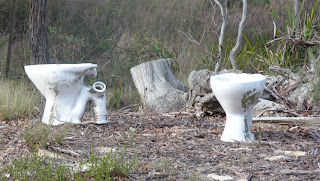ANPS is led down various roads
Warning: there are lotsa images in this post.
Today your humble blogger led the ANPS Wednesday Walk down Touga Rd, just East of Nerriga NSW. That is the first road. Or perhaps it is also the second road since the 1:25k topographic map calls this highway (hah!) Tolwong Road!
Que??? Unknown member of Fabaceae. Now known - thanks Jo - Bossiaea kiamensis
Touga Rd display of Acacia elongata
Rock shelf at point 2 in map image.
Possibly a greenhood rosette and last year's flower remnant. Alan Stephenson, author of the "Orchid species of the Shoalhaven" has advised that "The first rosette would be Hymenochilus but the rosette with slight brown edges is probably a rufa Pterostylis."
Possibly a Thelymitra sp leaf and last year's flower remnant.
Possibly an orchid leaf? Alan Stephenson, has also advised that this is an Eriochilus.
Possibly Microtis sp: there were a real lotta these!
Whatever: I had very good intentions (and we know what road is paved with them) in proposing this outing, and I am pleased to say they were met in spades (doubled, redoubled and made). Another road will be referred towards the end on this monster blog - I took about 75 snaps today, but will try to keep the number of images to somewhat less than that!
To get to Nerriga we went along a number of other roads and it seemed that the Oallen Ford Rd was paved with dunnies!
I am sure that when we came past a few weeks back there were three pedestals!
This Google Earth Extract shows the modus operandi, and gives an indication of the topogaphy.
The road below 1 is the highway from Braidwood to Nowra. We turned off there and while the group had morning tea I went and checked that the dirt road towards points 2 and 3 'went' (as we used to say in car rallies in the UK some 45 years ago). It did indeed go - I'd suspect graded in the last 3 weeks - and I greatly enjoyed the drive (7km each way way) proving this.
When I rejoined the group they were all very busy snuffling around the sandstone ledges at the intersection finding many flowering plants. Wot a contrast to the frosty hills of the ACT! Herewith some images. Hopefully the titles are not egregiously wrong!
Dillwynnia ramosissima
Banksia ericifolia
Banksia spinulosa
Acacia elongata
Leucopogon ericoides
Hakea sericea
Grevillea baueri
Boronia algida
Leucopogon fraseri
Kunzea parvifolia!! This flowers around November on our place!!
Drosera sp -high!
Drosera sp -low!
Lomandra obliqua: what are the white structures? Denis Wilson has advised that "sheath margins auriculate at top at least when young, intact, white."Photo from Plantnet shows very similar structures to the objects you noticed. http://plantnet.rbgsyd.nsw.gov.au/cgi-bin/NSWfl.pl?page=nswfl&photo=30&file=22/241/Lomandra%20obliqua.JPG"
Leptospermum rotundifolium
Calytrix tetragona
Touga Rd display of Acacia elongata
Rock shelf at point 2 in map image.
Epacris calvertiana under rock ledge at The Jumps
Sandstone pagoda at The Jumps
Dampiera stricta
Conospermum taxifolium: for those who like to translate scientific names from Latin to English, this one comes out to "the plant which is impossible to get in focus".
Isopogon anethifolius
Mirbelia platyloboides
Pomaderris andromedifolia
The final road is the road to Purgatory. I draw readers particular attention to the item about "in a non-specific sense, to mean any place or condition of suffering or torment" After much fruitless searching for any trace of orchids at sites 1 and 2, at site 3 I found lots of traces of same. I have very little idea - in some cases not even to genus - what they are. But I believe suffering should be shared so here you are! Denis has made some suggestions regarding ID in his comment on this post.Possibly a greenhood rosette and last year's flower remnant. Alan Stephenson, author of the "Orchid species of the Shoalhaven" has advised that "The first rosette would be Hymenochilus but the rosette with slight brown edges is probably a rufa Pterostylis."
Possibly a Thelymitra sp leaf and last year's flower remnant.
Possibly an orchid leaf? Alan Stephenson, has also advised that this is an Eriochilus.
Possibly Microtis sp: there were a real lotta these!
Returning briefly to dicotyledons
Actinotis minor (the small flannel flower)
A moss or fungus sporangium: this Cladonia was about 5mm high!



































Comments
Fortunately you have named most of the heath plants, Epacris, Leucopogons, and Leptospermums, etc. Well done.
The "Greenhoods" right, in a general sense. The moss beds and rock shelves are perfect habitat for some of the lesser-seen forms, such as the Prawn Orchid (Crangonorchis pedoglossa). But it is shrter than your seed pod seems to indicate. Hard to be sure, though, as some Orchids raise the Ovary higher as the seed pod develops.
Also lots of Speculanthas and the Pterostylis daintreana (old name) loves that area too.
The flat "arrow-head shaped leaf" might be an Eriochilus. Hard to tell, owing to lack of scale. They also love rock shelves.
The little red "Boxing-glove" Lichens are called Cladonia.
ANBG has some info on them and a range of photos.
http://www.anbg.gov.au/lichen/photos-captions/cladonia-f-356.html
Some of my favourite Lichens. They love dry areas.
Cheers
Denis
Re the Lomandra obliqua, PlantNET says: "sheath margins auriculate at top at least when young, intact, white."
Photo from that site, shows very similar structures to the objects you noticed.
http://plantnet.rbgsyd.nsw.gov.au/cgi-bin/NSWfl.pl?page=nswfl&photo=30&file=22/241/Lomandra%20obliqua.JPG
I have no idea why these plants need "ear-shaped" sheath margins - but that's what they are.
Cheers
Denis
Alan was having trouble with his Internet, but sent me the following message:
"the broad single leaf is an Eriochilus. The first rosette further up would be Hymenochilus but the rosette with slight brown edges is probably a rufa Pterostylis."
Regards
Alan